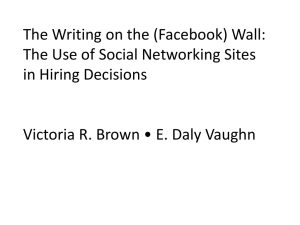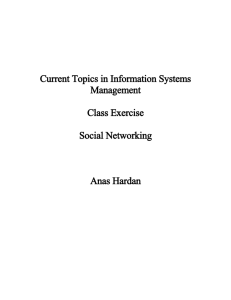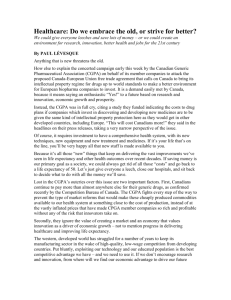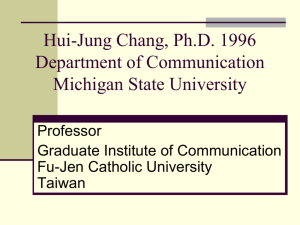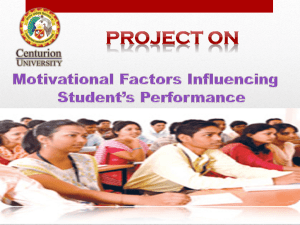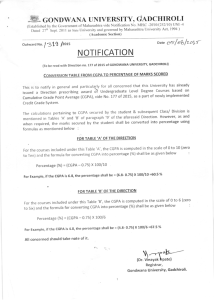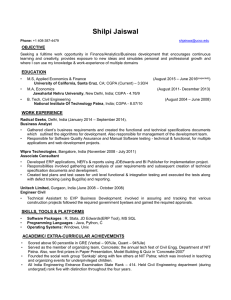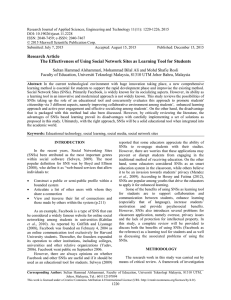Research Journal of Applied Sciences, Engineering and Technology 5(2): 361-369, ... ISSN: 2040-7459; E-ISSN: 2040-7467
advertisement
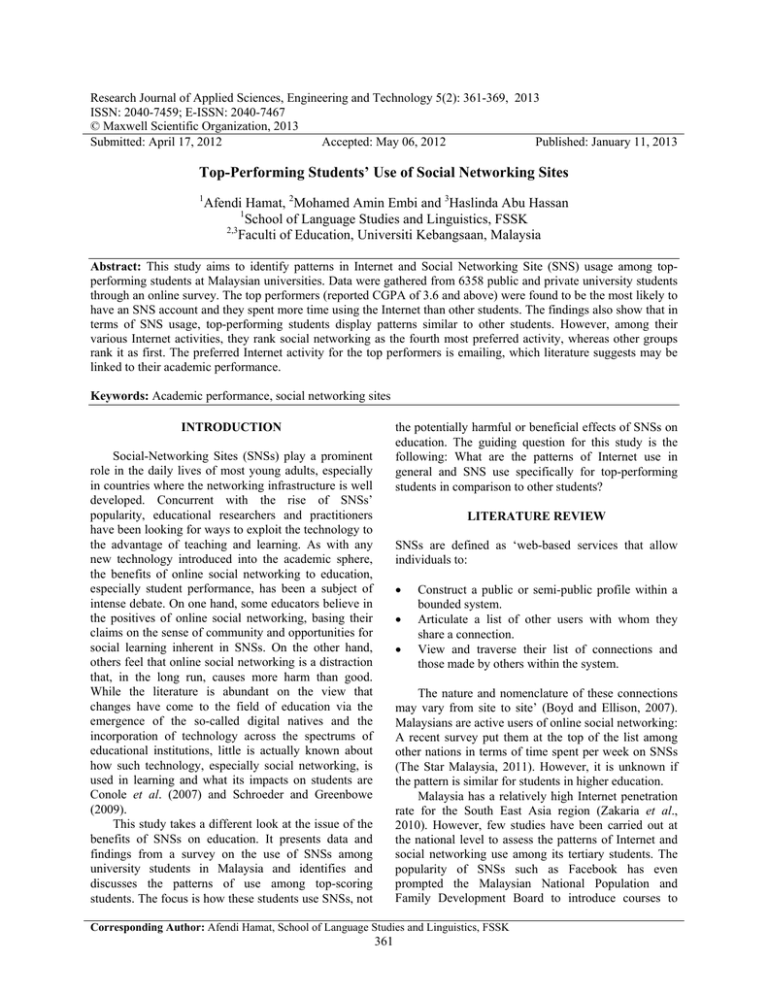
Research Journal of Applied Sciences, Engineering and Technology 5(2): 361-369, 2013 ISSN: 2040-7459; E-ISSN: 2040-7467 © Maxwell Scientific Organization, 2013 Submitted: April 17, 2012 Accepted: May 06, 2012 Published: January 11, 2013 Top-Performing Students’ Use of Social Networking Sites 1 Afendi Hamat, 2Mohamed Amin Embi and 3Haslinda Abu Hassan 1 School of Language Studies and Linguistics, FSSK 2,3 Faculti of Education, Universiti Kebangsaan, Malaysia Abstract: This study aims to identify patterns in Internet and Social Networking Site (SNS) usage among topperforming students at Malaysian universities. Data were gathered from 6358 public and private university students through an online survey. The top performers (reported CGPA of 3.6 and above) were found to be the most likely to have an SNS account and they spent more time using the Internet than other students. The findings also show that in terms of SNS usage, top-performing students display patterns similar to other students. However, among their various Internet activities, they rank social networking as the fourth most preferred activity, whereas other groups rank it as first. The preferred Internet activity for the top performers is emailing, which literature suggests may be linked to their academic performance. Keywords: Academic performance, social networking sites the potentially harmful or beneficial effects of SNSs on education. The guiding question for this study is the following: What are the patterns of Internet use in general and SNS use specifically for top-performing students in comparison to other students? INTRODUCTION Social-Networking Sites (SNSs) play a prominent role in the daily lives of most young adults, especially in countries where the networking infrastructure is well developed. Concurrent with the rise of SNSs’ popularity, educational researchers and practitioners have been looking for ways to exploit the technology to the advantage of teaching and learning. As with any new technology introduced into the academic sphere, the benefits of online social networking to education, especially student performance, has been a subject of intense debate. On one hand, some educators believe in the positives of online social networking, basing their claims on the sense of community and opportunities for social learning inherent in SNSs. On the other hand, others feel that online social networking is a distraction that, in the long run, causes more harm than good. While the literature is abundant on the view that changes have come to the field of education via the emergence of the so-called digital natives and the incorporation of technology across the spectrums of educational institutions, little is actually known about how such technology, especially social networking, is used in learning and what its impacts on students are Conole et al. (2007) and Schroeder and Greenbowe (2009). This study takes a different look at the issue of the benefits of SNSs on education. It presents data and findings from a survey on the use of SNSs among university students in Malaysia and identifies and discusses the patterns of use among top-scoring students. The focus is how these students use SNSs, not LITERATURE REVIEW SNSs are defined as ‘web-based services that allow individuals to: Construct a public or semi-public profile within a bounded system. Articulate a list of other users with whom they share a connection. View and traverse their list of connections and those made by others within the system. The nature and nomenclature of these connections may vary from site to site’ (Boyd and Ellison, 2007). Malaysians are active users of online social networking: A recent survey put them at the top of the list among other nations in terms of time spent per week on SNSs (The Star Malaysia, 2011). However, it is unknown if the pattern is similar for students in higher education. Malaysia has a relatively high Internet penetration rate for the South East Asia region (Zakaria et al., 2010). However, few studies have been carried out at the national level to assess the patterns of Internet and social networking use among its tertiary students. The popularity of SNSs such as Facebook has even prompted the Malaysian National Population and Family Development Board to introduce courses to Corresponding Author: Afendi Hamat, School of Language Studies and Linguistics, FSSK 361 Res. J. Appl. Sci. Eng. Technol., 5(2): 361-369, 2013 raise awareness of the ill effects of social media (Bernamas, 2011). Moreover, while the majority of Facebook users in Malaysia are between 18 and 34 years of age, not much is known about the pattern of use among tertiary students. The research presented in this study aims to remedy this shortcoming by surveying students across universities and colleges in Malaysia and identifying characteristics of Internet and SNS use among the top-performing students. The Internet and World Wide Web have captured the imagination of educators for the past two decades in a manner quite unmatched by other technologies introduced to education. The literature has established the benefits and value that Internet technologies bring into education. Among these technologies, SNSs are relatively recent additions to the list of applications made possible by the rapidly evolving Internet and web technologies. Although the sites and services termed ‘social-networking’ are relatively recent, the ideas behind them and the human tendency towards socializing are longstanding. This is evidenced by the popularity of listservs and discussion forums that dominated in the early days of the Internet, before the rise of the so-called ‘Web 2.0’ tools in the early 2000s. The main advantage of SNSs lies in their ability to form, or at least assist in forming, social connections between users. When taken together with the principles behind collaborative and social learning, the affordances offered by SNSs are greatly desirable in an online learning environment. This is because SNSs can easily and effectively reinforce social connections between individuals (Ellison et al., 2007). Collaborative learning depends on learners being able to act and learn collaboratively and most SNSs have ready tools to enable sharing and collaboration. Theories on social learning, for example, social constructivism, place a strong emphasis on learners constructing knowledge within defined social settings (Duffy and Cunningham, 1996). Research on the benefits of SNSs indicates several reasons for the use of SNSs in learning. Ferdig, for example, suggested four benefits of online social networking for students: scaffolding, active student participation, publishing of artefacts and participation in learning communities (Ferdig, 2007). Similar to Ferdig’s last point about participation in learning communities, Roblyer et al. (2010) suggested that the use of SNSs creates more opportunities for richer student-teacher interactions. Maloney (2007) claimed that the communal nature of Facebook should help to boost collaborative learning among users. In his study of a social bookmarking tool called Diigo, Curcher (2011) stated that use of the tool led to deeper learning engagement and that ‘use of social networking also had a secondary impact in that it moved learning from beyond the classroom and its formal setting’. Green and Bailey (2010) observed that Facebook could assist in the formation of study groups, although formal use of the platform is still rare. Ayling and Hebblethwaite (2011) stated that platforms like Facebook are helpful in building communities of practice, as they can reinforce existing offline ‘connections’ between people in the same community. It seems that the main advantage of SNSs lies in the nature of ‘connected’ and communicative online communities and most research in the literature seems to support this notion. However, this is not all that SNSs offer to learners: Ellison et al. (2007) argued the existence of strong social connections that leads to better ‘social capital’ seems to be helpful for students with low self-esteem and low life satisfaction. As students’ academic achievement can be influenced by many factors including low selfesteem, the use of SNSs could indirectly benefit students. METHODOLOGY The survey instrument used in this study is a 32item questionnaire. The instrument was previously validated for content and face validity through a pilot study involving 37 students at a local university. Additionally, the instrument was reviewed by five experts in educational and social sciences studies. After the questionnaire was revised based on the pilot study and expert reviews, the survey was administered through Survey Monkey online over a period of 6 weeks. The respondents (n = 6358) are students (both undergraduate and postgraduate) at institutions of higher learning in Malaysia. A survey is chosen as the method to investigate the guiding question, as it is the most suitable method to gather information on behavioural patterns across a large population (Ary et al., 2009). It should be noted that there are problems associated with online surveys; however, these problems, especially those regarding the issues of sampling, are inherent in other types of surveys as well (Wright, 2005). RESULTS The focus of this study is to investigate how topperforming students (those with reported CGPAs of 3.6 and above) use and perceive SNSs. The respondents are Malaysian university students. The following are the descriptive statistics of the sample population. Figure 1 and 2 above show some basic data on the respondents. As shown, 57.8% are female (n = 3673) and the rest are male (n = 2685). Respondents from the Sciences and Technologies represent over half of the total number at 58%, followed by those from the Social Sciences and Humanities at 36.6%. Students in the 362 Res. J. Appl. Sci. Eng. Technol., 5(2): 361-369, 2013 45.5% 26.5% 19.3% Fig. 1: Distribution by gender 7.3% 80 ow b el 2.5 to an d 2.6 2.0 to 3.5 to 2.0 36.6% 40 3.1 3.6 a nd a bov e 58% 60 3.0 1.4% Fig. 4: Reported CGPA 20 70.00% 5.4% 60.00% 59.90% 50.00% Social sciences and humanities Sciences technology Medical and health sciences 0 63.20% 53.20% 40.00% 30.00% 60.70% 40.70% 20.00% 10.00% Fig. 2: Field of study (%) 0.00% 2.0 and below 2.1 to 2.5 2.6 to 3.0 3.1 to 3.5 3.6 and above Fig. 5: Percentage of students who spend more than 3 h/day on the Internet 100 % 90 % Fig. 3: Have SNS accounts Medical and Health Sciences are the smallest group at 5.4%. Figure 3 shows that not all the respondents have SNS accounts. In fact, about one fifth of them do not. Figure 4 shows the breakdown of the respondents’ reported CGPAs. The majority (45.5%) reported a CGPA of 3.1 to 3.5 and 19.3% of the respondents are in the ‘top’ range of 3.6 to 4.0. For the purpose of this study, these respondents will be termed as ‘topperforming’ students and the pattern of their SNS use and perception will be reported in the following sections. Patterns of SNS and internet use: A cross-tabulation of reported CGPA and time spent on the Internet shows a statistical correlation between the two (χ2 (12, N = 80 % 81.90% 83.20% 76.80% 70 % 60% 80.20% 65.10% 2.0 and below 2.1 to 2.5 2.6 to 3.0 3.1 to 3.5 3.6 and above Fig. 6: Percentage of students who own SNS accounts 6358) = 42.28, p<0.001). Figure 5 shows the percentage of each CGPA group who reported spending more than 3 h online each day. Figure 5 shows that the top-performing students are more likely than the other groups to spend more than 3 h/day on the Internet. A total of 63.2% of the top performers reported doing so. However, an interesting pattern emerges from the chart displayed in Fig. 5: It 363 Res. J. Appl. Sci. Eng. Technol., 5(2): 361-369, 2013 Fig 7: Distribution of responses for ranking of online activities Yes Yes Yes Yes Yes 40.0% 30.0% 20.0% 10.0% in g gg B lo ng a ili ng 0.0% Em can be observed that the better the reported CGPA is, the more likely the group is to spend more than 3 h a day on the Internet. The next analysis looks at the correlation between reported CGPA and ownership of SNS accounts. The reported chi square for the cross-tabulation is (χ2 (4, N = 6358) = 25.04, p<0.001) which indicates that the null hypotheses is rejected and the relationship between the two variables is statistically significant. Figure 6 shows the percentage of students in each CGPA group who own SNS accounts. Figure 6 shows that the top-performing students are more likely to have an SNS account (83.2%). The line in Fig. 6 does not display a continuous rise as in Fig. 5 (It dips slightly at the CGPA of 3.1 to 3.5 groups). However, it is reasonable to say that there is a significant difference between the lowest (CGPA of 2.0 and below) and highest (CGPA of 3.6 and above) performing groups in terms of SNS account ownership. The next item to be analyzed is the amount of time spent per day on SNSs, as self-reported by the respondents. The answer options for the questionnaire items are the following: <1 h, between 1-2 and 2-3 h and >3 h. Their responses for this question were crosstabulated with their reported CGPA. The null hypothesis is that the time spent each day on SNSs is independent of the CGPA. The output of the exercise is (χ2 (12, N = 5027) = 14.67, p = 0.260). As p = 0.260, which is larger than 0.05; therefore, the null hypothesis is accepted. It appears that there is no statistical significance in the students’ responses to the question when cross-tabulated to their reported CGPA. Respondents were also asked to rank online activities in terms of the time they spend on each. The activities are Emailing, Social Networking, Learning, Significant? Yes 50.0% mi B lo gg in g ing a tt Ch ng Ga mi nin g S SN Le ar Em a il ing 0 Ga 500 g 1000 ng 1500 So n e t c ia l wo r ki n 2000 a t ti 2500 Ch 3000 Table 1: Online activities cross-tabulated with CGPA Chi square test Emailing (χ2 (20, N = 6358) = 69.35, p<0.001) Social (χ2 (20, N = 6358) = 32.95, p = networking 0.034) (SNS) Learning (χ2 (20, N = 6358) = 42.83, p = 0.002) Gaming (χ2 (20, N = 6358) = 37.28, p = 0.011) Chatting (χ2 (20, N = 6358) = 35.1, p = 0.02) Blogging (χ2 (20, N = 6358) = 51.41, p<0.001) in g 1 2 3 4 5 Le arn 3500 Fig. 8: Highest rated activities by CGPA of 3.6 and above group Gaming, Chatting and Blogging. They were ranked from 1 (the least amount of time) to 5 (the most). The histogram below (Fig. 7) shows the distribution of responses. Figure 7 shows that the respondents reported spending the most time on online social networking and learning. These two activities received the highest number of responses for activities ranked as 4 and 5, as seen in Fig. 7. The next step is to determine whether the responses for this question are statistically significant when cross-tabulated against CGPA Table 1 shows a summary of the activities crosstabulated against the respondents’ reported CGPA. As can be seen in Table 1, the responses for the listed activities are statistically not independent of the reported CGPA. This provides a strong basis to move to the next phase of analysis, investigating how top performers responded to the question about online activities. Figure 8 shows the activities arranged by the percentage of rating as 4 or 5 by the top-performing group. Emailing is ranked as first, followed by Learning, Chatting and Social Networking in fourth place. Gaming and Blogging are in fifth and sixth places, respectively. The respondents were also asked about their reasons for using SNSs (Q24 in the questionnaire). The 364 Res. J. Appl. Sci. Eng. Technol., 5(2): 361-369, 2013 4,000 3,000 3,000 2,000 2,000 1,000 0 0 1 2 3 4 5 Keeping touch with friends. 6 2,500 2,000 1,500 1,000 500 0 0 2 3 4 5 1 Discussing information related to courses . 6 2,500 2,000 1,500 1,000 500 0 2 0 1 3 4 5 6 Letting others know about what is happening in my... 1,000 0 2 0 1 3 4 5 6 Communicating with classmates . 2,500 2,000 1,500 1,000 500 0 0 2 3 4 5 1 6 Sharing information about courses at university 2,500 2,000 1,500 1,000 500 0 0 2 3 4 5 1 6 Connecting with people I have lost touch with, e.g... 2,500 6,000 2,000 5,000 1,500 1,000 500 0 0 1 2 3 4 Entertainment 5 6 365 4,000 3,000 2,000 1,000 0 0 1 2 3 4 Making money 5 6 Res. J. Appl. Sci. Eng. Technol., 5(2): 361-369, 2013 2,500 2,000 1,500 1,000 500 0 0 1 2 3 4 Showing my creativity 5 6 Fig. 9: Distribution of reasons for using SNS Table 2: Summary of cumulative logit model for Q24 and reported CGPA Test of model effects with CGPA as source p = 0.001 p<0.001 p<0.001 p<0.001 p = 0.007 p = 0.111 p = 0.133 p<0.001 p = 0.992 Keeping in touch with friends Communicating with classmates Discussing information related to courses taken at university Sharing information about courses at university Letting others know about what is happening in my life Connecting with people I have lost touch with, e.g., friends from school Entertainment (e.g., playing online games) Making money (e.g., conducting online business) Showing my creativity (e.g., creative writing, drawings, photos, songs) answer options given are displayed together with the distribution of their responses in Fig. 9. Figure 9 shows that ‘Keeping in touch with friends’ and ‘Communicating with classmates’ are the top two reasons the respondents use SNSs, while ‘Making money’ is the least cited purpose. For the next step of the analysis, a cumulative logit model was built in SPSS using the answer options given for the question on the purpose of SNS use (Q24), with each option as the dependent variable and the reported CGPA as the model. The model will help to determine: Whether there is any statistical relationship between the CGPA and the responses to Q24 The probability of those who reported having a CGPA of 3.6 and higher choosing the top option (5-most frequent use) Table 2 shows that of the 9 purposes of SNS use listed in Q24, six of them are not independent of CGPA. Based on this, we can say that the CGPA has an effect on the rating for most of the listed purposes in Q24. The top-performing students are also most likely to give a top rating to ‘Keeping in touch with friends’ (58.2%) and ‘Communicating with classmates’ (39.1%) while giving the lowest rating to ‘Making money’ (2.3%). Probability of a CGPA of 3.6 and above to rate ‘5’ (%) 58.2 39.1 24.5 23.1 17.7 28.4 8.8 2.3 6.5 The next part of the analysis examines the respondents’ perception of SNSs for informal learning. A summary of the overall student responses is shown in Fig. 10. Figure 10 show that the majority of the topperforming students (71.5%) believe that SNSs are helpful to their academic life. A majority of them (64.4%) also do not believe that using SNSs affects their academic performance. Slightly less than half of the top-performing group (46.8%) agrees that they spend more time on SNSs socializing rather than doing academic work. A total of 53.7% of the group find it more convenient to discuss course matters through SNSs with their friends. These findings indicate that the top-performing students are more likely as a group to have an SNS account, which seems to suggest that SNSs do not impair their performance as students. Additionally, 71.5% of the group does not believe their academic performance is affected by using SNSs or services. The group also tends to spend more time on the Internet (Fig. 5). However, while the most highly rated activity for the sample population is ‘Social networking’, the top performers rated ‘Emailing’ as their top activity, with ‘Social networking’ as fourth. The choice of email as the top-rated activity by this group of students is not unsurprising, as there is a strong relationship between student performance and use of email for improved communication with lecturers (Weiss and Hanson366 Res. J. Appl. Sci. Eng. Technol., 5(2): 361-369, 2013 Disagree/strongly disagree 21.20% 46.80% 14.60% 35.10% 64.400% 71.50% SN a c a Ss a d em re h ic l elpf ife ul a s to m as Us tu d y in g en t SN a c a Ss dem do ic p es no soc I spe erf t a ia l n d m orm ffec iz i ng y m an c t m rat ore y e h er tim th e e o nf nS or aca NS s dem for I fi ic w ork to n d th d is a t t cus i is SN es co more Ss urs wi e m conv th my atter enien frie s thr t nd oug s h 10.00% 57.30% Agree/strongly agree 80% 60% 40% 20% 0% Fig. 10: Use of SNSs for informal learning Baldauf, 2008). Although the topic is not covered by the current study, it would be beneficial if further research examined the features of email communications between Malaysian university students and their lecturers. Additionally, the survey also asked the respondents to report the time they spent daily on SNSs. However, no statistical correlation could be established between time spent on SNSs and CGPA (p = 0.260). A total of 57.3% of the top-performing group think it is more convenient to discuss course matters with their friends through SNS (compared with 61.2% of all students). This reflects the results of other studies such as student, which found 61% of respondents use SNSs for similar purposes and an NSBA report (NSBA, 2011), which mentions 60% of students in the survey talk about education on SNSs, with over 50% talking specifically about schoolwork. Tian et al. said that students use Facebook to help with logistical and collaborative aspects of their learning (Tian et al., 2011). The respondents in this survey were also asked if they use SNSs to contact their lecturers/tutors for help regarding course matters. A total of 50.3% of the respondents said ‘Yes’ and 49.7% said ‘No’. An almost similar distribution is seen for the top-performing group: 41.7% ‘Yes’ and 58.3% ‘No’. This is also a pattern observed in the literature, for example Hewitt and Forte (2006), Fischman (2008) and Chuang and Ku (2010), which suggests students are often equally split on the issue of having their lecturers as their ‘friends’ or contacting them regarding course matters on SNSs. Based on the distribution and probabilities displayed in Fig. 9 and Table 2, respectively, it can be concluded that top-performing students’ reasons for using SNSs are similar to those of the other groups. The respondents use SNSs mainly to keep in touch with friends and communicate with classmates. Malaysian students seem to take advantage of the strength of SNSs in regard to community building, as most of them agree that it is more convenient to discuss course matters via SNSs. The results of this study seem to support similar findings by researchers at the University of New Hampshire, that grades are not affected by SNS use (University of New Hampshire, 2009). The findings presented so far offer no compelling evidence that top performers in Malaysian universities make use of SNSs in any significantly different manner from their peers. The amount of time they spend on SNS could not be statistically correlated to CGPA and their reasons for using SNSs, as reported in the previous section, are similarly distributed to those reported by other CGPA groups. Further, their willingness to engage their lecturers on SNSs seems to be split along similar numbers when compared to other groups and previous research as well. It is very probable that the functions of a ‘social’ platform are not universally interpreted the same way by the students in this survey. Half of them use such platforms for contact with their lecturers, while the other half do not. CONCLUSION This study does not take a side in the debate on the pros and cons of social networking in education. The results, as mentioned, do not support either side of the debate. What the study brings to light is that educational researchers should look at how topperforming students use the Internet in general. The study found that this group is more likely to have an SNS account and spend more time on the Internet. However, top performers ranked ‘Social Networking’ in the fourth place in a list of various Internet activities, while students overall ranked it as first. Thus, it can be assumed that the top performers know how to better use their time online and perhaps their use of online social networking does not distract them from the activities they deem more important to their academic success. Further research on this topic is needed to create a clearer picture for educational researchers involved in the investigation of technology use in education. 367 Res. J. Appl. Sci. Eng. Technol., 5(2): 361-369, 2013 REFERENCES Ary, D., C.J. Jacobs, A. Razavieh and C.K. Sorenson, 2009. Introduction to Research in Education. 8th Edn., Wadsworth Publishing, California. Ayling, D. and D. Hebblethwaite, 2011. Facebook: From Offline to Online Communities of Practice in Practice-Based Learning. K.E. Zegwaard, (Ed.), New Zealand Association for Cooperative Education 2011 Conference Proceedings, Napier, New Zealand, 18-19 April, pp:19-23. Bernamas, 2011. Dewan Rakyat: Ministry to Introduce Awareness Programme on Negative Effects of Social Media. Retrieved from: http://kpwkm.bernama.com/news.php?id = 574275 (Last Accessed on: December 01, 2011). Boyd, D.M. and N.B. Ellison, 2007. Social network sites: Definition, history and scholarship. J. Comput. Mediat. Commun., 13: 210-230, DOI: 10.1111/j.1083-6101.2007.00393.x. Chuang, H.Y. and H.Y. Ku, 2010. Users’ attitudes and Perceptions toward Online Social Networking Tools. In: Gibson, D. and B. Dodge (Eds.), Proceedings of Society for Information Technology and Teacher Education International Conference, AACE, Chesapeake, VA, pp: 1396-1399. Conole, G., M. De Laat, T. Dillon and J. Darby, 2008. Disruptive technologies, pedagogical innovation: What’s new? Findings from an in-depth study of students’ use and perception of technology. Comput. Educ., 50: 511-524. Curcher, M., 2011. Constructing Their Learning: A Case Study of the Implementation of Social Bookmarking to Improve Student Learning and Collaboration with a Cohort of Engineering Students Learning in a Second Language Environment. In: Barton, S. et al. (Eds.), Proceedings of Global Learn Asia Pacific 2011, AACE, pp: 1031-1036. Duffy, T.M. and D.J. Cunningham, 1996. Constructivism: Implications for the Design and Delivery of Instruction. In: D.H. (Ed.), Handbook of Research for Educational Communications and Technology, Jonassen, Lawrence Erlbaum Associates, New Jersey. Ellison, N.B., C. Steinfield and C. Lampe, 2007. The benefits of Face book ‘‘friends:’’ Social capital and college students’ use of online social network sites. J. Comput. Mediat. Commun., 12(4). Fischman, J., 2008. Dear Professor, Students want to Chat with you. The Chronicle of Higher Education, Retrieved from: http://chronicle.com/wired campus/article/3384/dear-professor-students-wantto-chat-with-you, (Last accessed on: October 15, 2011). Ferdig, R.E., 2007. Editorial: Examining social software in teacher education. J. Techn. Teach. Educ., 15(1): 5-10. Green, T. and B. Bailey, 2010. Academic uses of facebook: Endless possibilities or endless perils? Tech. Trends, 54(3): 20-22. Hewitt, A. and A. Forte, 2006. Crossing Boundaries: Identity Management and Student/Faculty Relationships on the Face Book. Presented at the Computer Supported Cooperative Work Conference, Banff, Alberta, Canada, Retrieved from: http:// www. mendeley. com/ research/crossing-boundaries-identity- anagementand-student faculty-relationships-on-the-face book/2, (Last Accessed on: February 2, 2011). Maloney, E., 2007. What Web 2.0 can teach us about learning. Chronicle High. Educ., 53(18): B26. NSBA, 2011. Creating and Connecting: Research and Guidelines on Online Social-and EducationalNetworking. Retrieved from: http://www.nsba.org/ Services/TLN/BenefitsofMembership/Publications/ Creating-and-Connecting.pdf, (Last Accessed on: December 1, 2011 Roblyer, M.D., M. McDaniel, M. Webb, J. Herman and J.V. Witty, 2010. Findings on face book in higher education: A comparison of college faculty and student uses and perceptions of social networking sites. Inter. High. Educ., 13: 134-140. Schroeder, J. and T.J. Greenbowe, 2009. The chemistry of face book: Using social networking to create an online community for the organic chemistry laboratory. Innovate J. Online Educ., 5(4). The Star Malaysia, 2011. Survey: Malaysians have Most Face Book Friends. Retrieved from: From:http://thestar.com.my/news/story.asp?file=/2 010/10/13/nation/7212273&sec=nation, (Last Accessed on: July 25, 2011). Tian, S.W., A.Y. Yu, D. Vogel and R.C.W. Kwok, 2011. The impact of online social networking on learning: a social integration perspective. Int. J. Network. Virtual Organ., 8(3-4): 264-280. DOI: 10.1504/IJNVO.2011.039999. University of New Hampshire, 2009. Social Networking Usage and Grades among College Students: A Study to Determine the Correlation of Social Media Usage and Grades. Retrieved from: www.unh.edu/news/docs/UNHsocialmedia.pdf, (Last Accessed on: July 31, 2011). Weiss, M. and D. Hanson-Baldauf, 2008. E-Mail in academia: Expectations, use and instructional impact. Educause Quart., 31(1): 42-50. 368 Res. J. Appl. Sci. Eng. Technol., 5(2): 361-369, 2013 Wright, K.B., 2005. Researching Internet-based populations: Advantages and disadvantages of online survey research, online questionnaire authoring software packages and web survey services. J. Comput. Mediat. Commun., 10(3): article 11. Zakaria, M.H., J. Watson and S.L. Edwards, 2010. Investigating the use of Web 2.0 technology by Malaysian students. Multicult. Educ. Techn. J., 4(1): 17-29. 369
